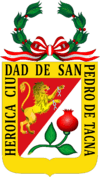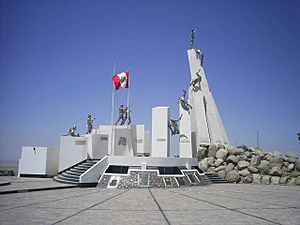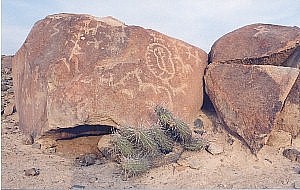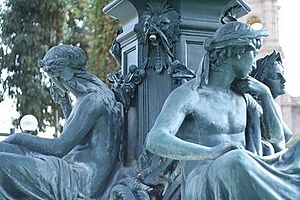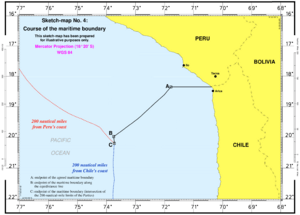Department of Tacna facts for kids
Quick facts for kids
Department of Tacna
|
|||
|---|---|---|---|
|
|||
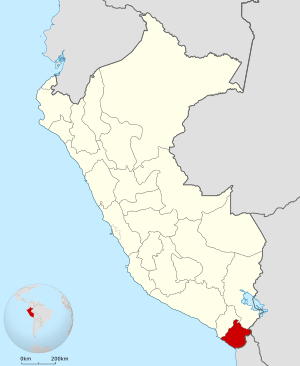
Location of the Tacna Region in Peru
|
|||
| Country | Peru | ||
| Subdivisions | 4 provinces and 26 districts | ||
| Capital | Tacna | ||
| Area | |||
| • Total | 16,075.89 km2 (6,206.94 sq mi) | ||
| Elevation
(Capital)
|
562 m (1,844 ft) | ||
| Highest elevation | 3,415 m (11,204 ft) | ||
| Lowest elevation | 0 m (0 ft) | ||
| Population
(2005 Census)
|
|||
| • Total | 274,496 | ||
| • Density | 17.07501/km2 (44.22408/sq mi) | ||
| UBIGEO |
23
|
||
| Dialing code | 052 | ||
| ISO 3166 code | PE-TAC | ||
| Principal resources | Grapevine, cotton, copper. | ||
| Poverty rate | 32.8% | ||
| Percentage of Peru's GDP | 1.7% | ||
| Website | www.regiontacna.gob.pe | ||
Tacna is a region in the southernmost part of Peru. It is known for being a very patriotic area in the country. The city of Tacna is its capital.
From 1885 to 1929, the Chilean Army occupied the Tacna Department. It was later returned to Peru.
Contents
Geography
The Tacna region is located in southern Peru. To its west is the Pacific Ocean. To the north, it borders the department of Moquegua. The department of Puno is to its northeast. To the east, it borders the Bolivian La Paz Department. Finally, to the south, it borders the Arica-Parinacota Region of Chile. The border with Chile is called La Línea de la Concordia.
Tacna is below the Titicaca plateau. It has many different types of land. You can find volcanoes, deserts, and mountains here. Rivers flow from these mountains, forming the region's water system. Even though Tacna is small, it has a lot of potential for mining and agriculture. It also has different climates, which allows for varied production.
Climate
Tacna gets a lot of sunshine all year. This is because of stable air and high pressure. The climate is a desert climate. This means it is very dry and sunny.
History
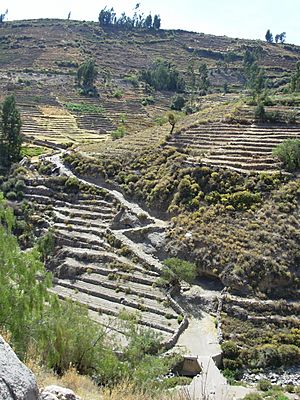
Ancient Times
People have lived in the Tacna region for over 10,000 years. Archaeological studies show that a civilization lived here during the Stone Age. The Toquepala Caves (from 7630 BC) and Abrigo de Caru (from 6240 BC) are examples from this time. Other sites like Girata Complex are still being studied.
Spanish Arrival
The first Spanish explorers came to Tacna in 1535. They were part of an expedition to conquer Chile. At that time, the city of Tacna was known as Villa San Pedro de Tacna. The city faced strong earthquakes in 1615 and 1784. Many towns were destroyed, but the people rebuilt them in the same places.
The 1800s
Tacna played a big role in Peru's fight for independence. Local patriots started planning for freedom in 1810. This was after their neighbors in Argentina declared independence. In 1811, Francisco Antonio De Zela made the first call for freedom in Tacna.
After Peru became independent, Tacna was honored for its bravery. In 1823, it was given the rank of villa. On May 26, 1828, President José de La Mar gave Tacna the title of Ciudad Heroica (Heroic City). This was to honor its brave people.
During the War of the Pacific against Chile, the people of Tacna fought bravely. They defended their nation with their lives.
Chilean Control
On May 26, 1880, after the Battle of Alto de la Alianza, the Chilean army took control of Tacna. A treaty said Chile would occupy Tacna and Arica for ten years. After that, people would vote to decide which country these areas belonged to.
However, Tacna stayed under Chilean control for 50 years. During this time, Chilean groups tried to make the local people feel Chilean. They wanted them to forget their Peruvian past. But Peruvian nationalists made sure this plan failed. The vote never happened.
Finally, in 1929, the Treaty of Lima was signed. Chile kept Arica, but Peru got Tacna back. Peru also received $6 million and other agreements.
Some important people lived in Tacna during the Chilean control. One was Salvador Allende and his family. They lived in the city for eight years. Salvador arrived in 1908 as a baby and studied at the Tacna School.
Ocean Border Dispute
In 2007, Peru and Chile had a disagreement about their ocean border. Peru said Chile's new map for a coastal area did not follow the agreed border. Peru believed Chile was claiming some of its land in the Tacna Department.
Peru's government said Chile had defined a new region without respecting the agreed border. They also said Chile was trying to extend its ocean border. Peru had claimed about 40,000 square kilometers of ocean territory for 50 years.
Chile, however, said the disputed area was not on the coast. They said it was an inland border marker. The Chilean government stated that their ocean borders were clear and recognized by other countries.
A possible border conflict was avoided. On January 26, 2007, Chile's highest court ruled that the new law was against their constitution. This law could have been seen as Chile trying to take Peru's ocean territory.
Peru's Foreign Minister said his country might go to the International Court of Justice in The Hague. This court helps countries solve disagreements.
On January 27, 2014, the International Court of Justice made its final decision. Peru gained some ocean territory. The new border extends 80 nautical miles (148 km) from the coast. From there, it runs southwest to a point 200 nautical miles (370 km) from both countries' coasts. This ruling meant Chile lost some of its claimed ocean territory, and Peru gained more.
Political Divisions
The Tacna Region is divided into four provinces. These provinces are made up of 26 districts.
Provinces
The provinces and their capital cities are:
Economy
Tacna's main source of money comes from copper mining. In terms of farming, Tacna produces over half of all the olives in Peru. Farmers also grow corn, potatoes, wheat, cotton, oregano, and grapes. The grapes are used to make wine and pisco (a type of brandy). The region also has many dairy cows and lambs.
Besides mining and farming, fishing is also very important. Tacna's ocean waters have many fish.
Local Customs
Traditional Foods and Drinks
Tacna offers many delicious and colorful dishes. Some local favorites are picante a la Tacneña and patazca Tacneña.
Other specialties include corn and cheese, chicharrones (fried pork) with toasted corn, and guinea pig chactado. You can also find corn cake with peanuts and raisins, baked pork, and grilled lamb.
To drink, Tacna has special macerated Brussels apricot and frutilla (a type of fruit) drinks. Local vineyards also produce wines.
Festivals
- Carnivals: These are celebrated in different towns. People enjoy local dances that can last for days and nights.
- April: Corn and Potato Festival in Tacna.
- May 26: Anniversary of the Battle of Alto de la Alianza.
- June 7: Anniversary of the Battle of Arica.
- June 20: Day to remember the Tacna patriot Francisco Antonio De Zela.
- June 23: Night of San Juan.
- August 28: Procesión de la Bandera (Flag Procession). This is a special and moving event. Women of Tacna carry the red and white Peruvian flag through the city streets. Later, groups of students, soldiers, and police parade. The parade ends in the main square, where the Arch of the Heroes is located. For a week, locals celebrate Tacna becoming part of Peru again. At the same time, there is a fair for farm products, livestock, industrial goods, and handicrafts.
See also
 In Spanish: Departamento de Tacna para niños
In Spanish: Departamento de Tacna para niños



